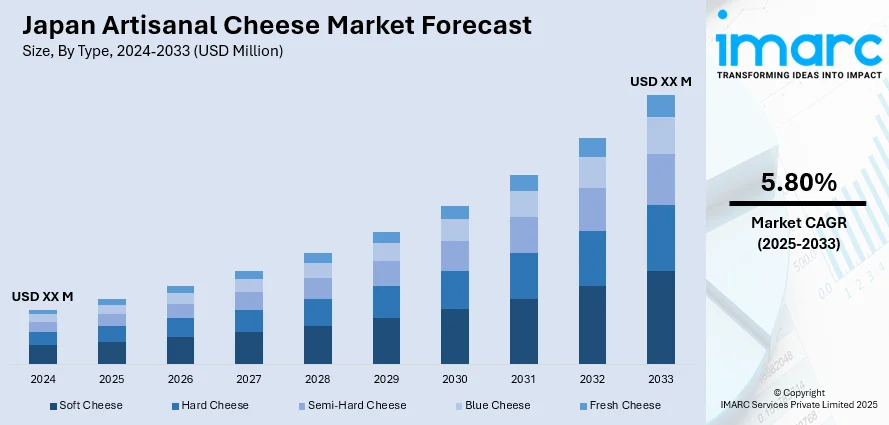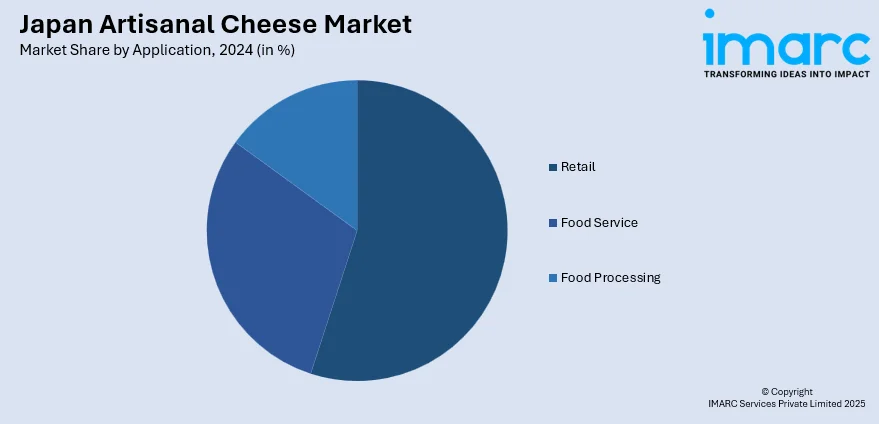
Japan Artisanal Cheese Market Size, Share, Trends and Forecast by Type, Application, Milk Source, Flavor Profile, Distribution Channel, and Region, 2025-2033
Japan Artisanal Cheese Market Overview:
The Japan artisanal cheese market size is projected to exhibit a growth rate (CAGR) of 5.80% during 2025-2033. The market is driven by growing demand for premium, locally-sourced artisanal cheeses, as discerning consumers prioritize quality, sustainability, and Japanese flavor profiles. The expansion of curated cheese pairing experiences in dining and retail, supported by social media and influencer marketing, is further elevating consumer engagement and education. Additionally, government initiatives and the "support local" movement continue to enhance domestic production across the country, further augmenting the Japan artisanal cheese market share.
|
Report Attribute
|
Key Statistics
|
|---|---|
|
Base Year
|
2024
|
|
Forecast Years
|
2025-2033
|
|
Historical Years
|
2019-2024
|
| Market Growth Rate 2025-2033 | 5.80% |
Japan Artisanal Cheese Market Trends:
Growing Demand for Premium and Locally-Sourced Artisanal Cheese
Artisanal cheese produced locally is increasingly being preferred in Japan as the demand from consumers is moving towards quality and the origin of cheese. Cheese used to be imported into Japan, but lately there has been renewed interest in the art of cheesemaking, and hence there has been an increase in small sellers of locally produced cheese in Japan. These retailers use conventional methods, add quality milk from local farms, and produce cheese specifically flavored for Japanese consumers, which includes mild, umami, and fruit-infused cheeses. The demand for Japanese artisanal cheeses has grown with the "support local" culture, where consumers care about sustainability and traceability, and have given Japanese artisanal cheese a try. Japanese artisanal cheeses can be found in specialty cheese stores, upscale supermarkets, and restaurants, which all have Japanese artisanal cheeses accompanied by local wines or sake. Additionally, government initiatives promoting dairy farming and cheesemaking skills are contributing to this trend. For instance, Japan's Ministry of Agriculture has set a five-year plan to modernize the dairy and beef sectors, which account for 42% of the nation's agricultural production. The imposition of stricter standards on dairy products and food safety is aimed at enhancing local economies and food self-sufficiency, hence contributing positively to the artisanal cheese industry. These reforms, coupled with increased safety precautions for probiotic fortification, signal a major step toward sustainable dairy farming and local cheese production. As a result, Japan’s artisanal cheese scene is gaining recognition both domestically and internationally, attracting cheese enthusiasts and food tourists.

Expansion of Cheese Pairing Experiences in Dining and Retail
The growing popularity of curated cheese pairing experiences, both in dining and retail settings is also propelling the Japan artisanal cheese market growth. High-end restaurants, wine bars, and specialty cafés are introducing cheese-tasting menus that combine artisanal cheeses with complementary foods, including honey, nuts, and Japanese condiments (e.g., miso or yuzu). Retailers are also capitalizing on this trend by offering subscription boxes, guided tasting sessions, and pairing workshops to educate consumers on cheese appreciation. Social media and influencer marketing have amplified interest, with visually appealing cheese boards becoming a cultural phenomenon. By 2025, influencer marketing in Japan is estimated to reach a value of 102.1 billion yen (approximately USD 0.69 Billion), propelled by platforms such as Instagram, YouTube, and TikTok that increase consumer engagement. As Japanese consumers become increasingly demanding of authentic and culturally relevant content, artisanal cheese brands can use influencers to create trust and extend their reach, particularly among young, fashion-forward audiences. Developments such as virtual influencers and short-form video posts offer new pathways for marketing unique cheese products to a technologically savvy public. Furthermore, luxury hotels and department stores are incorporating artisanal cheese counters, enhancing accessibility for urban consumers. This trend reflects a broader shift toward experiential gastronomy in Japan, where consumers seek not just high-quality products but also engaging, educational food experiences. As a result, cheesemakers and retailers are innovating with unique flavors and presentation styles to cater to this changing demand.
Japan Artisanal Cheese Market Segmentation:
IMARC Group provides an analysis of the key trends in each segment of the market, along with forecasts at the country and regional levels for 2025-2033. Our report has categorized the market based on type, application, milk source, flavor profile, and distribution channel.
Type Insights:
- Soft Cheese
- Hard Cheese
- Semi-Hard Cheese
- Blue Cheese
- Fresh Cheese
The report has provided a detailed breakup and analysis of the market based on the type. This includes soft cheese, hard cheese, semi-hard cheese, blue cheese, and fresh cheese.
Application Insights:

- Retail
- Food Service
- Food Processing
A detailed breakup and analysis of the market based on the application have also been provided in the report. This includes retail, food service, and food processing.
Milk Source Insights:
- Cow Milk
- Goat Milk
- Sheep Milk
- Buffalo Milk
The report has provided a detailed breakup and analysis of the market based on the milk source. This includes cow milk, goat milk, sheep milk, and buffalo milk.
Flavor Profile Insights:
- Mild
- Strong
- Spicy
- Sweet
A detailed breakup and analysis of the market based on the flavor profile have also been provided in the report. This includes mild, strong, spicy, and sweet.
Distribution Channel Insights:
- Online Retail
- Offline Retail
The report has provided a detailed breakup and analysis of the market based on the distribution channel. This includes online retail and offline retail.
Regional Insights:
- Kanto Region
- Kansai/Kinki Region
- Central/ Chubu Region
- Kyushu-Okinawa Region
- Tohoku Region
- Chugoku Region
- Hokkaido Region
- Shikoku Region
The report has also provided a comprehensive analysis of all the major regional markets, which include Kanto Region, Kansai/Kinki Region, Central/ Chubu Region, Kyushu-Okinawa Region, Tohoku Region, Chugoku Region, Hokkaido Region, and Shikoku Region.
Competitive Landscape:
The market research report has also provided a comprehensive analysis of the competitive landscape. Competitive analysis such as market structure, key player positioning, top winning strategies, competitive dashboard, and company evaluation quadrant has been covered in the report. Also, detailed profiles of all major companies have been provided.
Japan Artisanal Cheese Market Report Coverage:
| Report Features | Details |
|---|---|
| Base Year of the Analysis | 2024 |
| Historical Period | 2019-2024 |
| Forecast Period | 2025-2033 |
| Units | Million USD |
| Scope of the Report |
Exploration of Historical Trends and Market Outlook, Industry Catalysts and Challenges, Segment-Wise Historical and Future Market Assessment:
|
| Types Covered | Soft Cheese, Hard Cheese, Semi-Hard Cheese, Blue Cheese, Fresh Cheese |
| Applications Covered | Retail, Food Service, Food Processing |
| Milk Sources Covered | Cow Milk, Goat Milk, Sheep Milk, Buffalo Milk |
| Flavor Profiles Covered | Mild, Strong, Spicy, Sweet |
| Distribution Channels Covered | Online Retail, Offline Retail |
| Regions Covered | Kanto Region, Kansai/Kinki Region, Central/ Chubu Region, Kyushu-Okinawa Region, Tohoku Region, Chugoku Region, Hokkaido Region, Shikoku Region |
| Customization Scope | 10% Free Customization |
| Post-Sale Analyst Support | 10-12 Weeks |
| Delivery Format | PDF and Excel through Email (We can also provide the editable version of the report in PPT/Word format on special request) |
Key Questions Answered in This Report:
- How has the Japan artisanal cheese market performed so far and how will it perform in the coming years?
- What is the breakup of the Japan artisanal cheese market on the basis of type?
- What is the breakup of the Japan artisanal cheese market on the basis of application?
- What is the breakup of the Japan artisanal cheese market on the basis of milk source?
- What is the breakup of the Japan artisanal cheese market on the basis of flavor profile?
- What is the breakup of the Japan artisanal cheese market on the basis of distribution channel?
- What is the breakup of the Japan artisanal cheese market on the basis of region?
- What are the various stages in the value chain of the Japan artisanal cheese market?
- What are the key driving factors and challenges in the Japan artisanal cheese market?
- What is the structure of the Japan artisanal cheese market and who are the key players?
- What is the degree of competition in the Japan artisanal cheese market?
Key Benefits for Stakeholders:
- IMARC’s industry report offers a comprehensive quantitative analysis of various market segments, historical and current market trends, market forecasts, and dynamics of the Japan artisanal cheese market from 2019-2033.
- The research report provides the latest information on the market drivers, challenges, and opportunities in the Japan artisanal cheese market.
- Porter's five forces analysis assist stakeholders in assessing the impact of new entrants, competitive rivalry, supplier power, buyer power, and the threat of substitution. It helps stakeholders to analyze the level of competition within the Japan artisanal cheese industry and its attractiveness.
- Competitive landscape allows stakeholders to understand their competitive environment and provides an insight into the current positions of key players in the market.
Need more help?
- Speak to our experienced analysts for insights on the current market scenarios.
- Include additional segments and countries to customize the report as per your requirement.
- Gain an unparalleled competitive advantage in your domain by understanding how to utilize the report and positively impacting your operations and revenue.
- For further assistance, please connect with our analysts.
 Request Customization
Request Customization
 Speak to an Analyst
Speak to an Analyst
 Request Brochure
Request Brochure
 Inquire Before Buying
Inquire Before Buying




.webp)




.webp)












